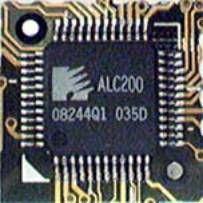ABIT SA6R Socket-370 i815E + RAID ATX
by Henry Kuo on November 13, 2000 2:09 PM EST- Posted in
- Motherboards
The Features
Unlike most i815/i815E motherboards, the SA6R has four DIMM slots instead of three. However, the board still only supports a maximum of 512MB SDRAM since this is a chipset limitation. The first two slots works like normal. But the third and fourth DIMM slots are sharing memory bank 5 and 6. Therefore, if you want to use both the third and fourth DIMM slots, two of the modules must be single-sided. If the SDRAM is all double-sided, a maximum of 3 DIMM slots can be occupied.
To most users, 512MB memory is more than enough for now, but this certainly won't be the case forever. Further, a decent server or workstation currently still requires 1GB or more memory, so 512MB is definitely not enough. This is not a fault of ABIT though; but rather is a limitation of the i815/i815E chipsets. Additionally, the i815/i815E chipsets also have some constraints on memory types. If you want to use PC133 SDRAM, only the first two DIMM slots can be populated. If users want to use all three DIMM slots, the memory will have to run in PC100 mode. If you don't feel like following the specifications put forth by Intel, the SA6R does allow you to run all modules in PC133 mode, but the system became quite unstable in our testing with this option enabled. So far the ASUS CUSL2 is the only i815E solution that we have tested that can run all three DIMMs in PC133 mode without sacrificing stability.
Below the first and second PCI slots is the 82810BA I/O Controller Hub 2 (ICH2), which is what differentiates the i815E chipset from the i815 chipset. The i815 chipset, which uses the 82810AA ICH1, only has Ultra ATA 66 support. The 82810BA ICH2 not only features Ultra ATA 100 support, but also adds a second USB controller and the Intel 82559 network controller. Together with the RAID controller, you can connect up to eight IDE devices.
The second USB controller allows two more USB devices on top of the original two. The original USB connectors are located at the back on the I/O panel, and ABIT puts the extra two USB headers on the left hand side of the motherboard. However, they did not include the necessary USB bracket to take advantage of those extra USB ports, so you will have to get your own expansion bracket or a USB hub if you want to connect more than two USB devices.
The SA6R features 6 PCI slots as part of its 6/0/1/1 (PCI/ISA/CNR/AGP) expansion slot setup, which should be enough for most users. The CNR slot is shared with the last PCI slot and provides access to the 82559 network controller integrated in the ICH2. The integrated network controller supports 10Mbps Home PNA 2.0 or 10/100 Ethernet depending on the CNR card that is plugged in. However, currently we only see a handful of suppliers of CNR cards, which is unfortunate because the 82559 network controller is quite good and the CNR cards are relatively cheap.
 The
SA6R uses the Avance Logic ALC200 AC'97 CODEC as their on-board sound solution.
AC'97 audio provides some basic sound functionality for users on a budget, but
for those who are serious about sound should definitely go for a true hardware-based
PCI solution.
The
SA6R uses the Avance Logic ALC200 AC'97 CODEC as their on-board sound solution.
AC'97 audio provides some basic sound functionality for users on a budget, but
for those who are serious about sound should definitely go for a true hardware-based
PCI solution.
ABIT's manuals are always highly regarded, and the SA6R is no exception. It gives you a step-by-step installation and configuration guide for your system, from how to install the motherboard, information on the jumpers / connectors, BIOS settings, all the way to drivers setup. It also has a section on RAID configuration BIOS setup, as well as instructions on how to install the RAID drivers under different OS's.










2 Comments
View All Comments
Sapnaoberoi1 - Friday, September 11, 2020 - link
Sapna oberoi is a famous delhi escortshttps://sapnaoberoi.com/
Mahipalpur escorts for you
https://sapnaoberoi.com/mahipalpur-escorts.html
Vasant Kunj escorts for you
https://sapnaoberoi.com/escort-service-in-vasant-k...
Karol bagh call girl
https://sapnaoberoi.com/karol-bagh-escorts.html
siya4521 - Wednesday, October 28, 2020 - link
Most Delhi Russian models see nude pic click nowhttp://www.russianescortservicesdelhi.com
https://www.realescortsservicedelhi.in/